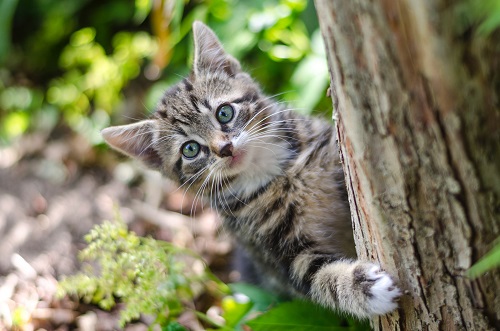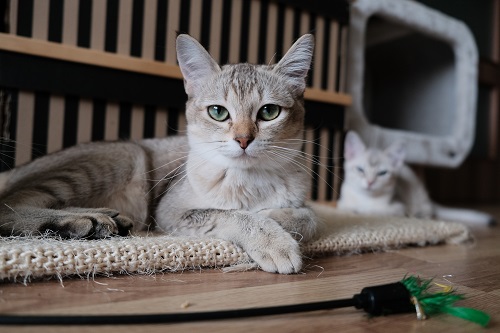The inability to urinate is a severe medical problem that if left untreated, can become fatal for your cat. Emergency medical action is the first step in dealing with a cat who all of a sudden cannot, or has not, been able to urinate. Whether the problem stems from a feline urinary tract infection or a urethral blockage, immediate medical attention is required to prevent your cat from becoming septic. If your cat has not peed in twenty-four hours, stop what you are doing and take your cat to the nearest emergency facility as soon as possible.
Signs Your Cat Can’t Pee
There are several signs that your cat can’t pee to look out for if you assume he has a problem. A healthy cat will pee anywhere between two and four times in 24 hours, depending on fluid intake. If you notice that there hasn’t been any indication of your cat urinating within twelve hours, begin to look for these following symptoms, as they may indicate that your cat is in serious medical trouble:
- licking his groin area excessively
- howling while using the litter box
- hiding
- making strange and uncomfortable noises
- excessive, unquenchable thirst followed by an immediate trip to the litter box
- frequent trips to the litter box with no pee
- vomiting
- sudden collapse
- seizures
If you see your cat go to the litter box multiple times within an hour, it is important to start monitoring his bathroom progress. After  your cat has made one or two trips to the litter box in a short period, check and see if he peed. If there are no visible signs of urine after multiple trips, take him to the vet right away. Don’t allow his struggle to urinate to continue. While the symptoms listed above are indicative of a urinary issue, only one or two symptoms need to be present to warrant emergency medical action.
your cat has made one or two trips to the litter box in a short period, check and see if he peed. If there are no visible signs of urine after multiple trips, take him to the vet right away. Don’t allow his struggle to urinate to continue. While the symptoms listed above are indicative of a urinary issue, only one or two symptoms need to be present to warrant emergency medical action.
It is vital to trust your instincts. As a cat owner, you know when something is wrong with your cat. Especially with urinary issues, the faster you act, the better your cat’s chances are of making a successful recovery. Do not wait until the situation becomes dire because he didn’t exhibit all of the symptoms. Even your suspicion that your cat has not peed in a long time is enough reason to bring him in for an examination.
Reasons Why Your Cat Can’t Pee
There are several causes of feline urinary retention, i.e., the inability of a cat to pee. Some of the most common reasons for urinary retention are as follows:
Cystitis (bladder infection)
Cystitis is a run of the mill bladder infection usually caused by excessive mineral deposits in the bladder due to a pH imbalance in a cat’s urine. These mineral deposits crystallize and when enough of them clump together, they can form a blockage in the urethra. Bladder infections can also be caused by a bacterial infection, which is typically treated with antibiotics administered at home. To determine what kind of urinary infection your cat is suffering from, your vet will need to perform a urinalysis, begin a urine culture, and take x-rays of the bladder itself.
FLUTD (Feline Lower Urinary Tract Disease)
This disease is the result of multiple bouts of cystitis. After a few bladder infections, the urinary tract becomes inflamed and susceptible to infection. Typically, FLUTD is related to kidney and bladder stones, which irritate the urethral passage and lower urinary tract. Treatment for FLUTD is similar to that of cystitis but can require more intensive treatments like a catheter and long term hospitalization.
Urethral Blockage
Most commonly attributed to urine crystallization, or stones, urethral obstruction occurs when the urethra is either partially or entirely  blocked. This severe condition typically requires emergency surgery and can result in sepsis if it is not treated with urgency. If you fear your cat is suffering from a urethral blockage based on the symptoms listed above, bring him in for an emergency examination immediately.
blocked. This severe condition typically requires emergency surgery and can result in sepsis if it is not treated with urgency. If you fear your cat is suffering from a urethral blockage based on the symptoms listed above, bring him in for an emergency examination immediately.
Not all cats are susceptible to urinary complications. Traditionally urinary tract infections, cystitis, and urethral blockages are most prevalent in male, indoor cats who are neutered. If your male indoor cat has a history of urinary infections or other complications, you may want to ask your vet about a long term medication. Sometimes a change in diet will help balance the pH of a cat’s urine so that urinary problems become less frequent. However, any medical change you make regarding your cat’s lifestyle should be discussed with and approved by your regular veterinarian.
When it comes to your cat’s urinary health, swift action is of the utmost importance. Due to the wide variety of complications that can manifest from urinary retention, you must be vigilant and proactive if and when you notice the onset of urinary symptoms. Remember, if your cat can’t pee, it’s time to go to the vet!
Sources:
“How Often Do Cats Pee?” FreakyPet, https://www.freakypet.com/blogs/news/how-often-do-cats-pee.
“How to Express Your Cat’s Bladder: HandicappedPets.” HandicappedPets.com, 20 Aug. 2019, https://www.handicappedpets.com/blog/how-to-express-cat-bladder/.
“Bladder Problems in Cats.” Royal Canin, https://www.royalcanin.com/au/cats/health-and-wellbeing/bladder-problems-in-cats.
Nicholas, Jason. “Help… My Cat Can’t Pee! Feline Urethral Obstruction: Be Aware.” Help… My Cat Can’t Pee! Feline Urethral Obstruction: Be Aware, https://www.preventivevet.com/cats/help-my-cat-cant-pee-feline-urethral-obstruction-be-aware.
“My Cat Can’t Pee! Difficulty Urinating in Cats.” PetMD, 8 Apr. 2017, https://www.petmd.com/cat/emergency/common-emergencies/e_ct_difficulty_urinating.




